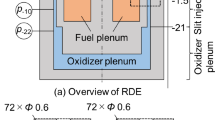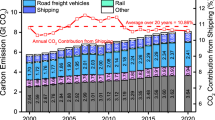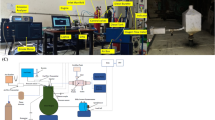Abstract
Using the efficient, space-saving, and flexible supercritical carbon dioxide (sCO2) Brayton cycle is a promising approach for improving the performance of nuclear-powered ships. The purpose of this paper is to design and compare sCO2 cycle power systems suitable for nuclear-powered ships. Considering the characteristics of nuclear-powered ships, this paper uses different indicators to comprehensively evaluate the efficiency, cost, volume, and partial load performance of several nuclear-powered sCO2 cycles. Four load-following strategies are also designed and compared. The results show that the partial cooling cycle is most suitable for nuclear-powered ships because it offers both high thermal efficiency and low volume and cost, and can maintain relatively high thermal efficiency at partial loads. Additionally, the new load-following strategy that adjusts the turbine speed can keep the compressor away from the surge line, making the cycle more flexible and efficient compared to traditional inventory and turbine bypass strategies.
Similar content being viewed by others
Abbreviations
- AT:
-
Auxiliary turbine
- EP:
-
Electric propulsion
- HTR:
-
High temperature recuperator
- IHX:
-
Intermediate heat exchanger
- LFR:
-
Lead-cooled fast reactor
- LTR:
-
Low temperature recuperator
- MCOM:
-
Main compressor
- MP:
-
Mechanical propulsion
- MT:
-
Main turbine
- PC:
-
Partial cooling cycle
- PCHE:
-
Printed circuit board heat exchanger
- PCOM:
-
Pre-compressor
- PWR:
-
Pressurized water reactor
- RC:
-
Recompression cycle
- RCOM:
-
Recycled compressor
- sCO2 :
-
supercritical CO2
- SFR:
-
Sodium-cooled fast reactor
- SR:
-
Simple recuperative cycle
- Tur:
-
Turbine
- C :
-
Cost/USD
- C BM :
-
The price of PCHE in per unit mass/USD·kg−1
- CEP:
-
The cost of every unit of cycle output power/USD·kW−1
- D :
-
Diameter/m
- d c :
-
Diameter of micro-channel/mm
- E input :
-
Exergy input to the sCO2 cycle/MW
- e :
-
Specific exergy/kJ·kg−1
- f c :
-
Moody friction coefficient
- f m :
-
The fraction of metal
- H :
-
Height of PCHE/m
- h :
-
Specific enthalpy/kJ·kg−1
- Δh :
-
Isentropic enthalpy change/kJ·kg−1
- htc:
-
Heat transfer coefficient/kW·(m2·K)−1
- HC:
-
Heat capacity/W·K−1
- I x :
-
Irreversibility of the xth component/%
- L :
-
Length of heat exchanger/m
- m :
-
Mass flow rate/kg·s−1
- m t :
-
Total turbine mass flow rate/kg·s−1
- N :
-
Shaft rotational speed/r·min−1
- N 1 :
-
The number of sub-exchangers
- N2:
-
The number of modules
- NTU:
-
The number of transfer units
- Nu :
-
Nusselt number
- n s :
-
Isentropic volume exponent
- P ti :
-
Turbine inlet pressure/MPa
- P to :
-
Turbine outlet pressure/MPa
- ΔP :
-
Pressure drop of heat exchanger/kPa
- p c :
-
Channel pitch/mm
- Pe :
-
Peclet number
- Pr :
-
Prandtl number
- Q :
-
Total heat load of the heat exchanger/MW
- Q th :
-
Thermal duty of the reactor/MW
- q :
-
The heat load of the sub-heat exchanger/MW
- R :
-
Gas constant/J·(kg·K)−1
- Re :
-
Reynolds number
- T min :
-
Cycle minimum temperature/°C
- Tti:
-
Turbine inelt temperature/°C
- ΔT IHX :
-
Pinch temperature difference of IHX/°C
- ΔT r :
-
Pinch temperature difference of recuperator/°C
- t :
-
The thickness of the plate/mm
- UA:
-
Thermal conductance of heat exchanger/W·K−1
- V hx :
-
Total volume of the cycle heat exchangers/m3
- v :
-
specific volume/m3·kg−1
- W :
-
Width of PCHE/m
- Wa:
-
Total electricity consumption of auxiliary facility and daily demand/MW
- WAT :
-
Power of the auxiliary turbine/MW
- WC :
-
Power of compressor/MW
- WMT :
-
Power of the main turbine/MW
- W net :
-
Net power output of sCO2 cycle/MW
- W p :
-
Propulsion power/MW
- W t :
-
Power of turbine/MW
- Z :
-
Gas compressibility
- ε :
-
Effectiveness of heat exchanger
- η c :
-
Compressor isentropic efficiency/%
- η ex :
-
Exergy efficiency of the sCO2 cycle/%
- η g :
-
Generator efficiency/%
- η gb :
-
Gearbox efficiency/%
- η m :
-
Motor efficiency/%
- η t :
-
Turbine isentropic efficiency/%
- η th :
-
Thermal efficiency of sCO2 cycle/%
- η * :
-
Dimensionless efficiency
- ρ m :
-
The density of the PCHE material/kg·m−3
- λ :
-
The thermal conductivity of the heat exchanger material/W·(m·K)−1
- φ * :
-
Dimensionless flow
- Ψ * :
-
Dimensionless head
- avg:
-
Average value
- d:
-
Design condition
- cold:
-
Heat exchanger cold side
- eq:
-
Equivalent value at turbomachine map conditions
- hot:
-
Heat exchanger hot side
- od:
-
Off-design condition
References
IMO. Fourth IMO Greenhouse Gas Study. International maritime organization, London, 2021.
Yoon H.J., Ahn Y., Lee J.I., Addad Y., Potential advantages of coupling supercritical CO2 Brayton cycle to water cooled small and medium size reactor. Nuclear Engineering and Design, 2012, 245: 223–232.
Oh B.S., Kim Y., Kim S.J., Lee J.I., SMART with Trans-Critical CO2 power conversion system for maritime propulsion in Northern Sea Route, part 1: System design. Annals of Nuclear Energy, 2020, 149(15): 107792.
Du Y., Yang C., Hu C., Zhang C., Thermoeconomic analysis and inter - stage pressure ratio optimization of nuclear power supercritical CO2 multi - stage recompression. International Journal of Energy Research, 2020, 45(2): 2367–2382.
Du Y., Yang C., Hu C., Zhou M., Thermodynamic design and Off-design investigation of nuclear power supercritical CO2 recompression cycle. Nuclear Engineering and Design, 2020, 369(1): 110851.
Park J.H., Park H.S., Kwon J.G., et al., Optimization and thermodynamic analysis of supercritical CO2 Brayton recompression cycle for various small modular reactors. Energy, 2018, 160: 520–535.
Floyd J., Alpy N., Moisseytsev A., et al., A numerical investigation of the sCO2 recompression cycle off-design behaviour, coupled to a sodium cooled fast reactor, for seasonal variation in the heat sink temperature. Nuclear Engineering and Design, 2013, 260: 78–92.
Guo Z., Zhao Y., Zhu Y., et al., Optimal design of supercritical CO2 power cycle for next generation nuclear power conversion systems. Progress in Nuclear Energy, 2018, 108: 111–121.
Lee J., Lee J.I., Yoon H.J., et al., Supercritical carbon dioxide turbomachinery design for water-cooled small modular reactor application. Nuclear Engineering and Design, 2014, 270: 76–89.
Li M., Jie Y., Zhu H., et al., The thermodynamic and cost-benefit-analysis of miniaturized lead-cooled fast reactor with supercritical CO2 power cycle in the commercial market. Progress in Nuclear Energy, 2018, 103: 135–150.
Li M., Xu J., Cao F., et al. The investigation of thermo-economic performance and conceptual design for the miniaturized lead-cooled fast reactor composing supercritical CO2 power cycle. Energy, 2019, 173: 174–195.
Luo D., Huang D., Thermodynamic and exergoeconomic investigation of various sCO2 Brayton cycles for next generation nuclear reactors. Energy Conversion and Management, 2020, 209(1): 112649.
Dostal V., Driscoll M.J., Hejzlar P., A supercritical carbon dioxide cycle for next generation nuclear reactors. Massachusetts Institute of Technology, Boston, USA, 2004.
Moisseytsev A., Sienicki J.J., Transient accident analysis of a supercritical carbon dioxide Brayton cycle energy converter coupled to an autonomous lead-cooled fast reactor. Nuclear Engineering and Design, 2008, 238(8): 2094–2105.
Moisseytsev A., Sienicki J.J., Investigation of alternative layouts for the supercritical carbon dioxide Brayton cycle for a sodium-cooled fast reactor. Nuclear Engineering and Design, 2009, 239(7): 1362–1371.
Wu P., Ma Y., Gao C., et al., A review of research and development of supercritical carbon dioxide Brayton cycle technology in nuclear engineering applications. Nuclear Engineering and Design, 2020, 368: 110767.
Li Z., Liu X., Shao Y., Zhong W., Research and development of supercritical carbon dioxide coal-fired power systems. Journal of Thermal Science, 2020, 29(3): 546–575.
Combs O.V., An investigation of the supercritical CO2 cycle (Feher cycle) for shipboard application. Massachusetts Institute of Technology, Boston, USA, 1977.
Oh B.S., Kim S.J., Kim Y., Lee J.I., SMART with trans-critical CO2 power conversion system for maritime propulsion in Northern Sea Route, part 2: Transient analysis. Annals of Nuclear Energy, 2021, 150: 107875.
Pérez-Pichel G.D., Linares J.I., Herranz L.E., Moratilla B.Y., Thermal analysis of supercritical CO2 power cycles: Assessment of their suitability to the forthcoming sodium fast reactors. Nuclear Engineering and Design, 2012, 250: 23–34.
Zhu H., Xie G., Yuan H., Nizetic S., Thermodynamic assessment of combined supercritical CO2 cycle power systems with organic Rankine cycle or Kalina cycle. Sustainable Energy Technologies and Assessments, 2022, 52: 102166.
Pham H.S., Alpy N., Ferrasse J.H., et al., Mapping of the thermodynamic performance of the supercritical CO2 cycle and optimisation for a small modular reactor and a sodium-cooled fast reactor. Energy, 2015, 87: 412–424.
Moisseytsev A., Sienicki J.J., Dynamic control analysis of the AFR-100 SMR SFR with a supercritical CO2 cycle and dry air cooling: part I — plant control optimization. 26th International Conference on Nuclear Engineering, London, UK, 2018.
Oh B.S., Ahn Y.H., Yu H., et al., Safety evaluation of supercritical CO2 cooled micro modular reactor. Annals of Nuclear Energy, 2017, 110: 1202–1216.
Baek J.Y., Lee J.J., Lee J.I., Transient analyses of the S-CO2 Cycle coupled to PWR for nuclear marine propulsion. Transactions of the Korean Nuclear Society Virtual Spring Meeting, Republic of Korea, 2020.
Carstens N., Control strategies for supercritical carbon dioxide power conversion systems. Massachusetts Institute of Technology, Boston, USA, 2007.
Lock A., Bone V., Off-design operation of the dry-cooled supercritical CO2 power cycle. Energy Conversion and Management, 2022, 251: 114903.
Thanganadar D., Fornarelli F., Camporeale S., et al., Off-design and annual performance analysis of supercritical carbon dioxide cycle with thermal storage for CSP application. Applied Energy, 2021, 282: 116200.
Wan X., Wang K., Zhang C.M., et al., Off-design optimization for solar power plant coupling with a recompression supercritical CO2 Brayton cycle and a turbine-driven main compressor. Applied Thermal Engineering, 2022, 209: 118281.
Yang J., Yang Z., Duan Y., Off-design performance of a supercritical CO2 Brayton cycle integrated with a solar power tower system. Energy, 2020, 201: 117676.
Yang J., Yang Z., Duan Y., Part-load performance analysis and comparison of supercritical CO2 Brayton cycles. Energy Conversion and Management, 2020, 214: 112832.
Yu J.C., Marine nuclear power technology. Shanghai Jiaotong University Press, Shanghai, 2016.
Aoto K., Uto N., Sakamoto Y., et al., Design study and R&D progress on Japan sodium-cooled fast reactor. Journal of Nuclear Science and Technology, 2011, 48(4): 463–471.
White M.T., Bianchi G., Chai L., et al., Review of supercritical CO2 technologies and systems for power generation. Applied Thermal Engineering, 2021, 185: 116447.
Ragheb M., Nuclear Naval Propulsion. IntechOpen, London, 2011.
Nuclear-Powered Ships. https://world-nuclear.org/information-library/non-power-nuclear-applications/transport/nuclear-powered-ships.aspx, 2021 (accessed on March 13, 2023).
Grandy C., Kim T.K., Jin E., et al., Advanced fast reactor - 100 - design overview. International Atomic Energy Agency (IAEA), New York, 2015.
Molland A.F., Marine engines and auxiliary machinery. The Maritime Engineering Reference Book, Oxford, Butterworth-Heinemann, 2008, pp. 344–482.
Xu J., Sun E., Li M., et al, Key issues and solution strategies for supercritical carbon dioxide coal fired power plant. Energy, 2018, 157: 227–246.
Demirel Y., Energy: production, conversion, storage, conservation, and coupling. Springer Science & Business Media, 2012.
Roshanfekr P., Lundmark S., Thiringer T., et al., A synchronous reluctance generator for a wind application-compared with an interior mounted permanent magnet synchronous generator. 7th IET International Conference on Power Electronics, Machines and Drives (PEMD 2014), Manchester, UK, 2014, pp. 1–5. DOI: https://doi.org/10.1049/cp.2014.0411.
Pabiszczak S., Kowal M., Efficiency of the eccentric rolling transmission. Mechanism and Machine Theory, 2022, 169: 104655.
Mikityuk K., Heat transfer to liquid metal: Review of data and correlations for tube bundles. Nuclear Engineering and Design, 2009, 239(4): 680–687.
Wang Y., Xie G., Zhu H., et al., Assessment on energy and exergy of combined supercritical CO2 Brayton cycles with sizing printed-circuit-heat-exchangers. Energy, 2023, 263: 125559.
Wright S.A., Radel R.F., Vernon M.E., et al., Operation and analysis of a supercritical CO2 Brayton cycle, Sandia report, USA, 2010. DOI:https://doi.org/10.2172/984129
Pham H.S., Alpy N., Ferrasse J.H., et al., An approach for establishing the performance maps of the sc-CO2 compressor: Development and qualification by means of CFD simulations. International Journal of Heat and Fluid Flow, 2016, 61: 379–394.
Dyreby J.J., Modeling the supercritical carbon dioxide Brayton cycle with recompression. The University of Wisconsin-Madison, Madison, USA, 2014.
Fuller R., Preuss J., Noall J., Turbomachinery for supercritical CO2 power cycles. American Society of Mechanical Engineers, 2012, 44717: 961–966. DOI: https://doi.org/10.1115/GT2012-68735
Arenas Pinilla E.M., Cantizano González A., Asenjo Pedraza I., et al., Design and analysis of radial and axial turbomachinery of supercritical CO2 power cycles. http://hdl.handle.net/11531/36538, 2019.
Liu J., Yan S., Zeng D., A new measurement model for main steam flow of power plants. Procedia Environmental Sciences, 2011, 11: 18–24.
Li S., Wang Z., Gas turbine performance analysis. Harbin Institute of Technology Press, Harbin, 2017.
Carlson M.D., Middleton B.M., Ho C.K., Techno-economic comparison of solar-driven sCO2 Brayton cycles using component cost models baselined with vendor data and estimates. ASME 2017 11th International Conference on Energy Sustainability. DOI: https://doi.org/10.1115/ES2017-3590
Sarkar J., Second law analysis of supercritical CO2 recompression Brayton cycle. Energy, 2009, 34(9): 1172–1178.
Acknowledgements
This work was supported by the National Natural Science Foundation of China (52276150).
Author information
Authors and Affiliations
Corresponding author
Ethics declarations
On behalf of all authors, the corresponding author states that there is no conflict of interest.
Electronic supplementary materials
Rights and permissions
About this article
Cite this article
Li, Z., Shi, M., Shao, Y. et al. Supercritical CO2 Cycles for Nuclear-Powered Marine Propulsion: Preliminary Conceptual Design and Off-Design Performance Assessment. J. Therm. Sci. 33, 328–347 (2024). https://doi.org/10.1007/s11630-023-1896-6
Received:
Published:
Issue Date:
DOI: https://doi.org/10.1007/s11630-023-1896-6




